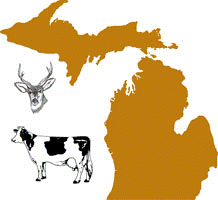Wildlife Disease and Zoonotics
Date of this Version
7-30-2003
Abstract
The spread of infectious disease among and between wild and domesticated animals has become a major problem worldwide. Upon analyzing the dynamics of wildlife growth and infection when the diseased animals cannot be identified separately from healthy wildlife prior to the kill, we find that harvest-based strategies alone have no impact on disease transmission. Other controls that directly influence disease transmission and/or mortality are required. Next, we analyze the socially optimal management of infectious wildlife. The model is applied to the problem of bovine tuberculosis among Michigan white-tailed deer, with non-selective harvests and supplemental feeding being the control variables. Using a two-state linear control model, we find a two-dimensional singular path is optimal (as opposed to a more conventional bang-bang solution) as part of a cycle that results in the disease remaining endemic in the wildlife. This result follows from non-selective harvesting and intermittent wildlife productivity gains from supplemental feeding.



Comments
Paper prepared for presentation at the American Agricultural Economics Association Annual Meeting, Montreal, Canada, July 27-30, 2003